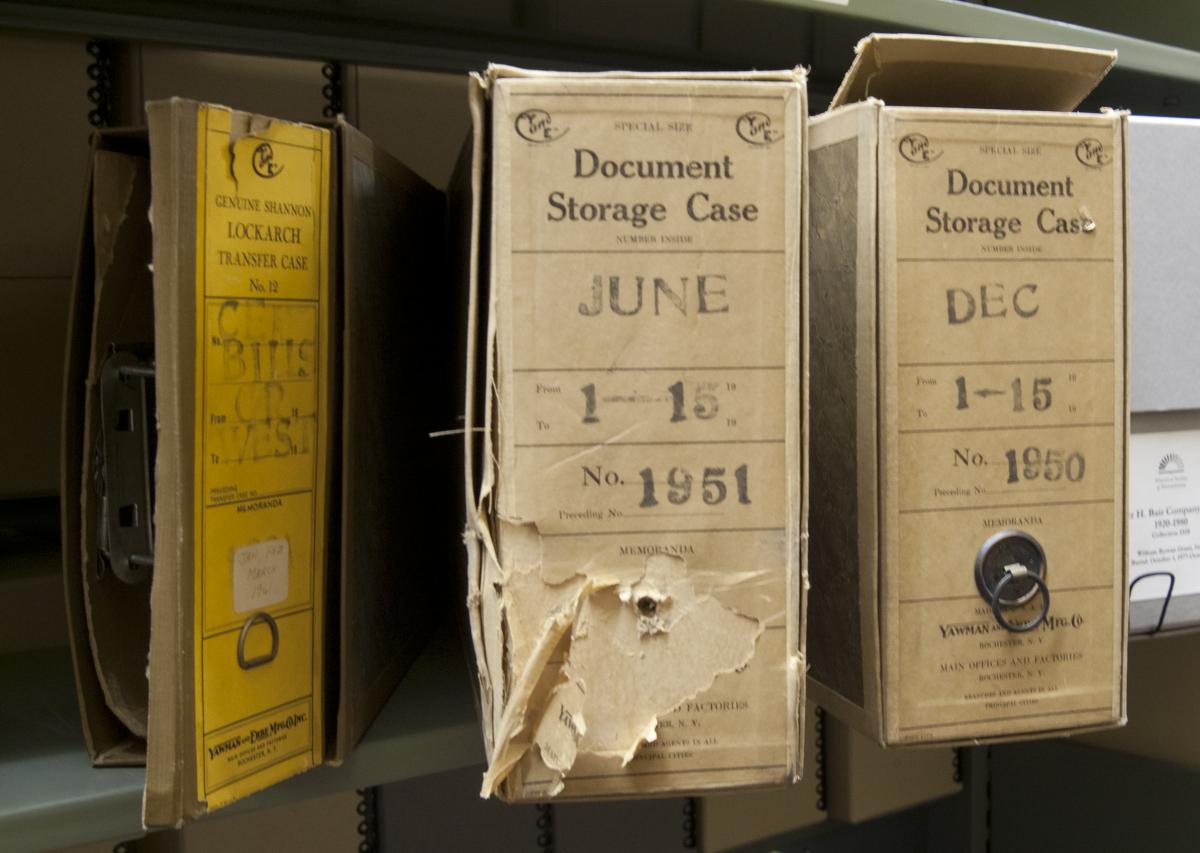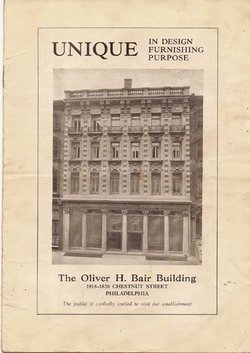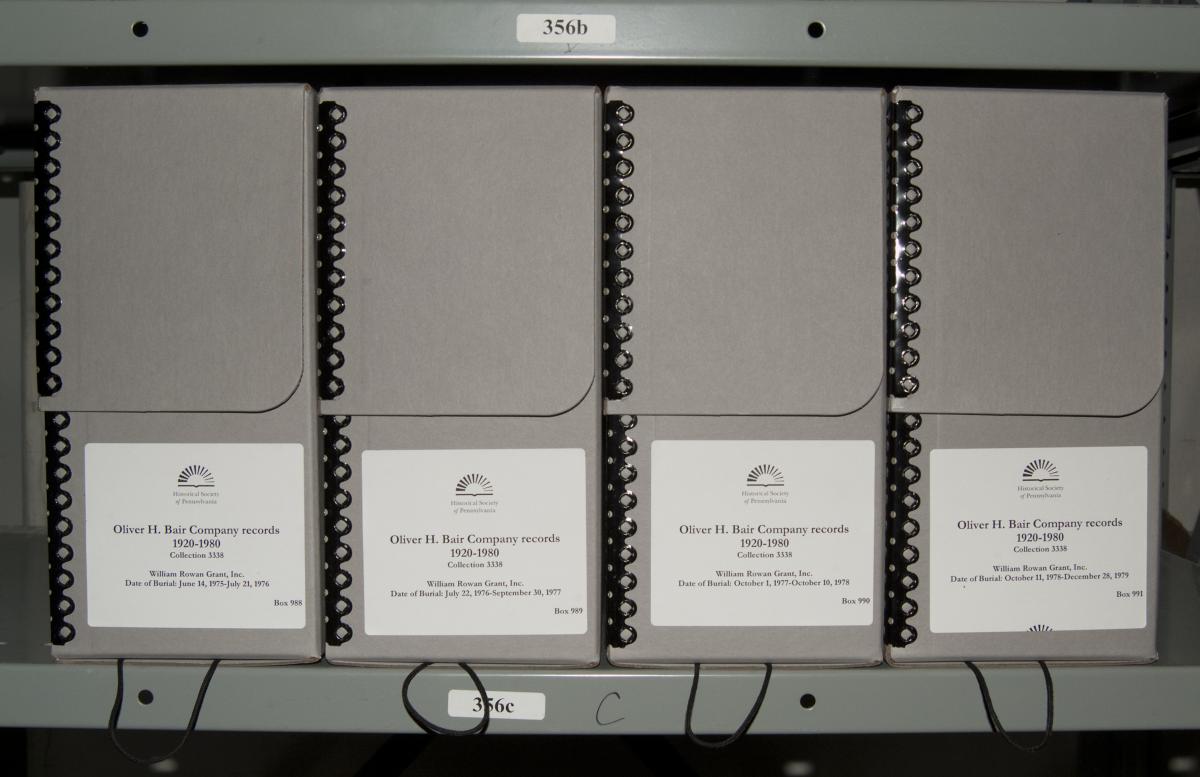In the fall of 2011, through a generous grant by Ancestry.com I was given the task of re-housing the Historical Society of Pennsylvania’s largest funeral home collection, the Oliver H. Bair Company collection. The collection consists of over 1050 boxes of burial records that the company had amassed over six decades of operation, from 1920-1980 to be exact. My duties included organizi ng the collection, conducting minor upkeep on the records, and moving the collection from old, out of date boxes into newer, acid free boxes that will help preserve the records for decades to come. I have also been tasked with creating a finding aid for the collection, allowing researchers to locate information about the collection in our online catalog or to give them a better understanding of the collection when they visit HSP.
ng the collection, conducting minor upkeep on the records, and moving the collection from old, out of date boxes into newer, acid free boxes that will help preserve the records for decades to come. I have also been tasked with creating a finding aid for the collection, allowing researchers to locate information about the collection in our online catalog or to give them a better understanding of the collection when they visit HSP.
The Oliver H. Bair Company is a staple in the community in Philadelphia, and has been serving the area since 1878  when Oliver H. Bair founded the funeral company after he deemed that funeral services needed to be more personable and comforting to families during such an emotional time. The company began on 41 North Eighteenth St. in Philadelphia; however their most famous location is at 1820 Chestnut St in the Rittenhouse Square neighborhood of Philadelphia. In 2007 John J. Monaghan purchased the Oliver H. Bair Company, and the funeral home is now located at 8500 West Chester Pike in Upper Darby. Mr. Monaghan also owns the Monaghan Funeral Home, located at 612 Main St. in Red Hill.
when Oliver H. Bair founded the funeral company after he deemed that funeral services needed to be more personable and comforting to families during such an emotional time. The company began on 41 North Eighteenth St. in Philadelphia; however their most famous location is at 1820 Chestnut St in the Rittenhouse Square neighborhood of Philadelphia. In 2007 John J. Monaghan purchased the Oliver H. Bair Company, and the funeral home is now located at 8500 West Chester Pike in Upper Darby. Mr. Monaghan also owns the Monaghan Funeral Home, located at 612 Main St. in Red Hill.
The physical records that make up the Oliver H. Bair collection consist of a simple template, but include a wide variety of materials. Simply put the Oliver H. Bair collection is a compilation of burial records over the span of sixty years. There is a manila envelope that contains any and all information needed by Oliver H. Bair to conduct business with the deceased person’s family or designated agent. Within the envelope is an informational sheet that displays the deceased’s date of death, date of burial, biographical information, specifications for their burial, doctor’s notes, former residence, among other basic but pertinent information. Often there will also be some correspondence between the funeral home and family of the deceased discussing payment methods and dates. Some envelopes also contain newspaper clippings pertaining to the deceased, and most have short obituaries within the envelope as well. In rare cases the correspondence within an envelope can become quite lengthy, as occasionally law firms are contacted to aid in the bill collection process or to mediate family squabbles over what is to be done with the deceased person’s estate. Smaller objects have also appeared in the collection, including a coin purse (ironically with no coins inside, only paper) and a small book consisting of the deceased’s placement history while he served in the Navy. In the future a blog post (or two) will highlight some of the more remarkable records found in this collection, demonstrating that history and enlightenment can appear at any time. This collection is proving its value in multiple ways: it is not only helpful to genealogists tracing their family’s lineage, but also users interested in history and welcoming surprises as the records residing in this collection are full of stories, information, and of course, history!
biographical information, specifications for their burial, doctor’s notes, former residence, among other basic but pertinent information. Often there will also be some correspondence between the funeral home and family of the deceased discussing payment methods and dates. Some envelopes also contain newspaper clippings pertaining to the deceased, and most have short obituaries within the envelope as well. In rare cases the correspondence within an envelope can become quite lengthy, as occasionally law firms are contacted to aid in the bill collection process or to mediate family squabbles over what is to be done with the deceased person’s estate. Smaller objects have also appeared in the collection, including a coin purse (ironically with no coins inside, only paper) and a small book consisting of the deceased’s placement history while he served in the Navy. In the future a blog post (or two) will highlight some of the more remarkable records found in this collection, demonstrating that history and enlightenment can appear at any time. This collection is proving its value in multiple ways: it is not only helpful to genealogists tracing their family’s lineage, but also users interested in history and welcoming surprises as the records residing in this collection are full of stories, information, and of course, history!

